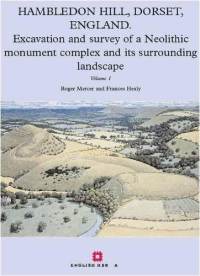Immortal Meals #11: Feasts at Hambledon Hill January 13, 2013
Author: Beach Combing | in : Prehistoric , trackbackAnother from the Immortal Meal series: this time beef steak on Hambledon Hill in Dorset (UK) c. 5000 years ago as a warm September evening is resolving itself. Hambledon Hill, for those who had not had the pleasure, is an extraordinary Iron Age hill fort on the edge of the upland region of western England. It is not particularly beautiful, it is not scenic. The place has, however, charisma. Let’s leave it at that and move onto the menu.
Long before the Iron Age fort was built Hambledon Hill had been a gathering place for local populations in the transition between hunter-gathering and farming. We know this because three barrows were put on the heights containing the bones of the various communities that lived in the locality in the Neolithic period. Around these were dug a series of pits – ‘causewayed enclosures’ – which contained within them the remains of meals and human skulls (below). So much for the game pieces, how do we put these on the board?
Archaeologists know very little at the best of times, and in the case of Neolithic communities they know very very little. It is only right then to be modest about the interpretations for HH. However, there is a broad consensus that Hambledon Hill was not a Neolithic settlement, but rather, as many sites with causewayed enclosures, an occasional meeting place for clans from the surrounding plain. It was certainly a place where bodies were lain out to be defleshed by the elements and wild beasts and birds: there may even have been a defleshing platform.
Bodies were carefully defleshed before bones were placed in the barrows. There have even been mutterings about cannibalism. Certainly, those who came here to feast were violent if violence and cannibalism need be tied together. Of the skulls examined by archaeologists from the site several had potentially fatal head blows near the left temple, the classic ‘clue’ for injuries picked up in hand to hand combat. Interestingly women were as likely to have these wounds as men and women’s bones were treated, apparently, with special care. Along with ‘cannibalism’ there has even been muttering of ‘matriarchy’!
The pits near the barrows were dug and filled, dug and filled repeatedly with earth and animal and sometimes human bones. It has been suggested that clans came here to feast and then dug any leftovers into the pits in, to judge by the age of the killed animals, in late summer and early autumn. Would it be too much to imagine a pit per clan: the human skulls found towards the base might have been ancestral figures or an original sacrifice? Fish were not eaten to judge by the isotope readings in human bones: given the amount of fresh water in the area it sounds like this was a we-are-not-like-you taboo.
The animal bones were typically from domesticated cows – this was a community that had begun the Neolithic Revolution – but there were also red deer and other wild beasts. Cow bones were treated like human bones with a certain decorum: were cows part of the family then? In pottery from the site there was also evidence of dairy products: often taken as a marker of advanced agriculture, the so-called secondary products revolution. The pits then were the repository for the food eaten and given the proximity of the funeral barrows perhaps we should imagine the food placed into the pit, repeatedly, for the ancestors to gourge themselves on.
So why would Beachcombing like to go back and sit around this fire and chew on some calf brain with Neolithic Dorseters? Well, we do not have here the earliest Britons. But they are the earliest with character. The refusal to eat fish, the violent duels, the prominence of women, the elaborate care of the dead, the affection for the cows they ate… These are not just bones in the earth. Finally, we have people.
Beach is always on the look out for immortal meals: drbeachcombing AT yahoo DOT com
***
22 Jan 2013: Aldous Huxley writes: What you talk about is very similar to the suppositions put down in Stonehenge: Where Atlantis Died by Harry Harrison and Leon Stover.The plot tied together suppositions of Myceneans mining tin in Cornwall in their struggle with Atlantis which sourced its tin from the Black Sea area….but the majority of the action takes place around Stonehenge and the culture there. Harrison and Stover posited that the henges were gathering places for Autumn feasting, politics and burying the dead, and posited a culture around personal combat and herding and dairying. They do state that they used a lot of the particulars from Irish hero tales, but they do support the conclusions on the archeology of the time (1970’s) I recommend it as a fun read. Harrison makes it readable, Stover makes it plausible…well, up to the eruption of Santorini, but even that made a pretty good plot element. Thanks Aldous!




